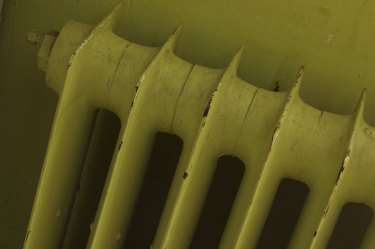Things You'll Need
Vacuum
Duster, optional
Plastic drop cloth
Water
Mild detergent
Microfiber cloths
Sponge
Soft-bristled brush, optional

Steam heating systems that use cast iron steam radiators--valve-controlled cast iron coil assemblies--distribute steam through a series of pipes throughout a building. Many people find cast iron steam radiators difficult to clean as the hot radiator surfaces attract dust, dirt and other debris. In addition, the paint applied to the radiator's surfaces to increase heating efficiency can easily fleck or peel with little scrubbing or abrasion. Cleaning cast iron steam radiators is not impossible because you can easily remove most dirt with a vacuum and/or duster and mild or gentle cleaning products.
Step 1
Turn the radiator valve(s) at the base of your cast iron radiator to shut off the steam and cool your radiator's surface. If you are pre-cleaning and have not turned on your radiators, skip this step.
Video of the Day
Step 2
Attach a soft-bristled brush or upholstery brush head to the hose of your vacuum and lightly vacuum dust, dirt, cobwebs or other debris from your cast iron steam radiator's coils, valve(s) and/or heat reflector (if applicable) as well as the floor and baseboard. If the brush head will not fit into certain areas (between coils or under/behind the radiator), dust the areas with a fabric thread-style or microfiber style duster.
Step 3
Lay a plastic drop cloth on the floor beneath and around your radiator before cleaning with soap and detergent so that you protect the floor.
Step 4
Wipe your cast iron steam radiator--coils, valves and pipes--with a soapy lint-free microfiber cloth. Wait 10 minutes for the chemicals in the detergent you used to break up any oils clinging to the radiator's surfaces. In addition, wipe your foil reflector (if applicable).
Step 5
Rub a damp sponge over all the radiator surfaces to remove the soap residue. Rinse the sponge and repeat as needed.
Step 6
Blot undiluted mild detergent on caked-on dirt and stains. Wait 10 to 20 minutes. Rub with a damp sponge to remove the dirt, oil or staining material and then rinse.
Step 7
Remove the plastic drop cloth.
Step 8
Turn the radiator valve(s) on to dry the radiator and surrounding surfaces. If a great deal of moisture remains or you skipped Step 1, dry the radiator, pipes, floor, baseboard and/or heat reflector with soft, lint-free microfiber cloths.
Tip
If you cannot remove dirt or a stain, brush the dirt or stain with a soft-bristled brush. Brush the top of the dirty/stained spot in a gentle, circular motion until the dirt and/or stain breaks away or fades.
Warning
Always wait until the cast iron surface of your radiator(s) has cooled before cleaning so that you do not burn yourself on the radiator’s surface. Never dust your radiator with a feather or fine thread duster that can snag or easily pull as loose feather and fibers/thread can stick to the radiator, not only causing a reduction in heating efficiency, but also posing a potential fire hazard. Never use a soft-bristled brush unless you are cleaning debris from the valves or dealing with tough or caked-on dirt/stains. In addition, brush only the top of the dirty/stained surface instead of any surrounding surfaces to protect the paint.
Video of the Day